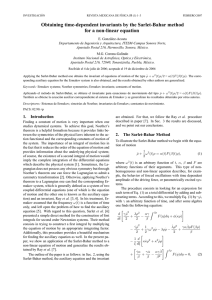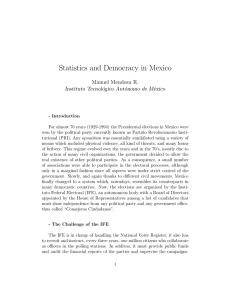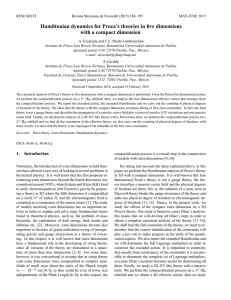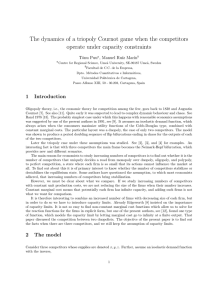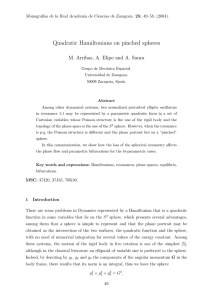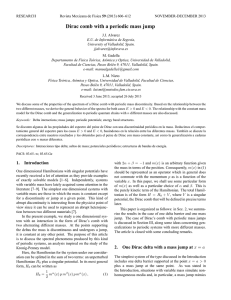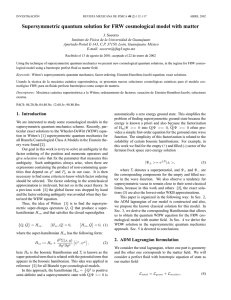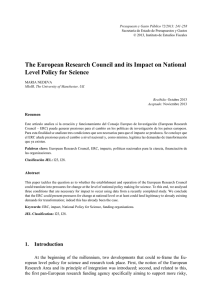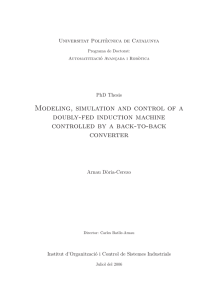Geometry and Dynamics of Nonholonomic Systems
Anuncio
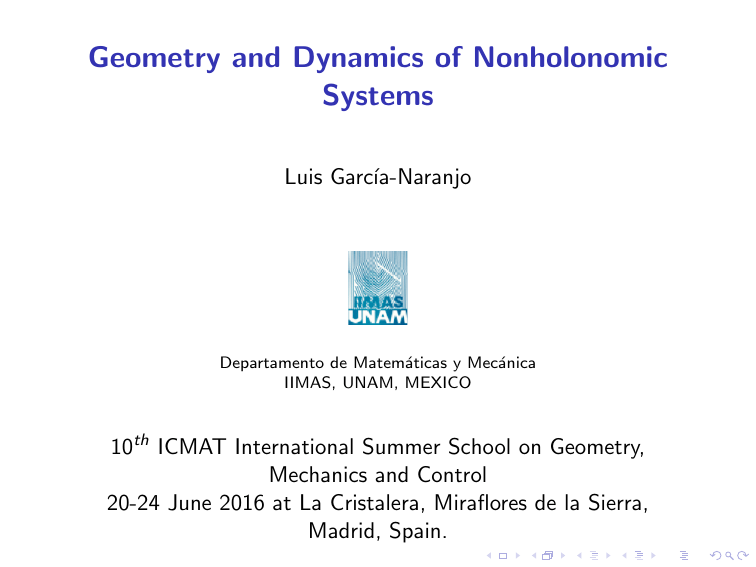
Geometry and Dynamics of Nonholonomic
Systems
Luis Garcı́a-Naranjo
Departamento de Matemáticas y Mecánica
IIMAS, UNAM, MEXICO
10th ICMAT International Summer School on Geometry,
Mechanics and Control
20-24 June 2016 at La Cristalera, Miraflores de la Sierra,
Madrid, Spain.
Holonomic Constraints
Pendulum
Geometric Constraint. Restriction in coordinate values.
Configuration space is not R2 but S 1 .
Nonholonomic Constraints
Chaplygin Sleigh
Kinematic Constraint:
ẏ cos φ = ẋ sin φ
No constraint on the configurations.
Suslov Problem
Kinematic Constraint:
ha, Ωi = 0
No constraint on the configurations. Q = SO(3).
Suslov Problem
Kinematic Constraint:
ha, Ωi = 0
No constraint on the configurations. Q = SO(3).
Veselova Problem
Kinematic Constraint:
he3 , ωi = 0
No constraint on the configurations. Q = SO(3).
Veselova Problem
Kinematic Constraint:
he3 , ωi = 0
No constraint on the configurations. Q = SO(3).
Chaplygin Top
Kinematic Constraint: Rolling without slipping.
No constraint on the configurations. Q = SO(3) × R2 .
Rigid body dynamics
Body frame. Not inertial. Attached to the body.
Space and body frames
Change of basis matrix is B ∈ SO(3).
q = BQ
Angular velocity vector
In body coordinates:
0
−Ω3 Ω2
0
−Ω1
B −1 Ḃ = Ω̂ = Ω3
−Ω2 Ω1
0
Left invariant
In space coordinates:
ḂB −1
Right invariant
0
−ω3 ω2
0
−ω1
= ω̂ = ω3
−ω2 ω1
0
Suslov Problem
Constraint:
ha, Ωi = 0
Lagrangian:
L = hIΩ, Ωi
Suslov problem
Ω̇1 = −
1
((I13 Ω1 + I23 Ω2 )Ω2 ) ,
I11
1
Ω̇2 =
((I13 Ω1 + I23 Ω2 )Ω1 ) .
I22
1
E = (I11 Ω21 + I22 Ω22 )
2
Ω2
I13Ω1+I23Ω2=0
Ω1
Veselova problem
he3 , ωi = hγ, Ωi = 0
IΩ̇ = (IΩ) × Ω + λγ
λ=−
h(IΩ) × Ω, I−1 γi
hγ, I−1 γi
γ̇ = γ × Ω
Equations on TS 2
Chaplygin Top
u̇ = B(ρ × Ω)
mü = −mge3 + R1 ,
IΩ̇ = (IΩ) × Ω + R2
R2 =mρ × (Ω × (ρ × Ω)) + mρ × (ρ̇ × Ω)
+ mρ × (ρ × Ω̇) + mg ρ × γ
IΩ̇ = (IΩ) × Ω + R2
ρ = −Rγ − `E3
Equations on S 2 × R3
γ̇ = γ × Ω
Smooth convex body rolling on the plane
R2 =mρ × (Ω × (ρ × Ω)) + mρ × (ρ̇ × Ω)
+ mρ × (ρ × Ω̇) + mg ρ × γ
IΩ̇ = (IΩ) × Ω + R2
If surface is given by f (ρ) = 0 with f : R3 → R
γ=−
∇f (ρ)
,
||∇f (ρ)||
γ̇ = γ × Ω
Ellipsoid rolling on the plane
R2 =mρ × (Ω × (ρ × Ω)) + mρ × (ρ̇ × Ω)
+ mρ × (ρ × Ω̇) + mg ρ × γ
IΩ̇ = (IΩ) × Ω + R2
ρ= p
−Aγ
hAγ, γi
,
A = diag (a2 , b 2 , c 2 )
γ̇ = γ × Ω
Nonholonomic equations of motion
d
dt
∂L
∂ q̇ i
−
∂L
= Ri ,
∂q i
β(q)q̇ = 0
Equivalent to:
d
dt
∂Lc
∂v α
= ρiα (q)
∂Lc
∂Lc
γ
− Cαβ
(q)v β γ
∂q i
∂v
q̇ i = ρiα (q)v α
Example: Chaplygin sleigh
ẋ sin θ − ẏ cos θ = 0
1
L = ((J + ma2 )θ̇2 + m(ẋ 2 + ẏ 2 ) + 2maθ̇(ẏ cos θ − ẋ sin θ))
2
ma
∂
∂
∂
⊥
D = span Y =
+ sin θ
− cos θ
J + ma2 ∂θ
∂x
∂y
Example: Chaplygin sleigh
1
= 0,
C12
2
C12
=−
ma
J + ma2
1
Lc (u, ω, x, y , θ) = ((J + ma2 )ω 2 + mu 2 )
2
mu̇ = maω 2
(J + ma2 )ω̇ = −mauω
Example: Suslov problem
d
dt
∂Lc
∂v α
a = E3 ,
= ρiα (q)
∂Lc
∂Lc
γ
− Cαβ
(q)v β γ ,
∂q i
∂v
Ω3 = 0,
q̇ i = ρiα (q)v α
1
Lc (B, Ω1 , Ω2 ) = (I11 Ω21 + I22 Ω22 )
2
I11 Ω̇1 = − ((I13 Ω1 + I23 Ω2 )Ω2 ) ,
I22 Ω̇2 = ((I13 Ω1 + I23 Ω2 )Ω1 ) .
Ḃ = B Ω̂.
Hamiltonian formulation
d
dt
∂Lc
∂v α
= ρiα (q)
∂Lc
∂Lc
γ
− Cαβ
(q)v β γ
i
∂q
∂v
q̇ i = ρiα (q)v α
Equivalent to:
∂H
∂H
γ
− Cαβ
(q)pγ
k
∂pβ
∂q
∂H
q̇ i = ρiα (q)
∂pα
ṗα = −ρkα (q)
Xnh is tangent to F
Properties of F
1. Integrable if and only if constraints are holonomic.
2. F is symplectic
3. Xnh characterized by
iXnh Ω|F = dH|F
Distributional Hamiltonian approach Bates, Cushman, etc
4. Ibort, de León, Marrero, Martı́n de Diego:
{f , g }nh (m) = Ωm (Rm (Xf˜(m)), Rm (Xg̃ (m)))
=⇒ The span of the “Hamiltonian” vector fields Xfnh with
f ∈ C ∞ (D ∗ ) is the distribution F.
Conclusion: The bracket {·, ·}nh satisfies the Jacobi identity if and
only if the constraints are holonomic.
Example. Chaplygin sleigh
Lc =
1
(J + ma2 )ω 2 + mu 2 .
2
and
1
C12
= 0,
2
C12
=−
ma
.
J + ma2
We have
∂Lc
= mu,
∂u
The Hamiltonian is
pω =
pu =
H=
1
2
∂Lc
= (J + ma2 )ω.
∂ω
pω2
p2
+ u
2
J + ma
m
.
The equations of motion:
pu
pω
pu
cos θ,
ẏ =
sin θ,
θ̇ =
ẋ =
m
m
J + ma2
mapω2
apu pω
ṗu =
,
ṗω = −
,
(J + ma2 )2
J + ma2
0
0
0
cos θ
x
y 0
0
0
sin θ
d
θ= 0
0
0
0
dt
pu − cos θ − sin θ 0
0
ma
pθ
0
0
−1 − J+ma
2 pω
∂Hc
∂x
∂Hc
∂y
∂Hc
∂θ .
∂H
ma
c
p
ω
2
J+ma
∂pu
∂Hc
0
0
0
1
∂pω
Rank 4 matrix. Null space
(− sin θ, cos θ, 0, 0, 0)
Constraint one-form
− sin θ dx + cos θ dy .
F=
∂
∂ ∂ ∂
∂
cos θ
+ sin θ , ,
,
∂x
∂y ∂θ ∂pu ∂pω
Measure preservation of homogeneous systems in vector
spaces
ẋ = f (x),
x ∈ Rn .
f homogeneous of degree k ∈ N: i.e. f (λx) = λk f (x).
Kozlov ‘88: f preserves a smooth measure µ(x) dx if and only if it
preserves the euclidean measure dx and µ(x) is a conserved
quantity.
∂H
∂H
γ
− Cαβ
(q)pγ
∂pβ
∂q k
∂H
q̇ i = ρiα (q)
∂pα
ṗα = −ρkα (q)
Suppose there is no potential energy
1
H(q i , pα ) = p T (AD (q))−1 p
2
Kozlov: Invariant measure must be basic µ(q) dq ∧ dp.
Example: Suslov problem
1
((I13 Ω1 + I23 Ω2 )Ω2 ) ,
I11
1
Ω̇2 =
((I13 Ω1 + I23 Ω2 )Ω1 ) .
I22
Ω̇1 = −
Invariant measure if and only if I13 = I23 axis of forbidden rotations
is a principal axis of inertia.
Symmetry reduction of nonholonomic systems
Nonholonomic system: Q, L, D.
Free and proper action of Lie group G on Q
Ψ:G ×Q →Q
Tangent lift
Ψ̂ : G × TQ → TQ
Suppose that Ψ̂ preserves L and D. Action on D
Φ : G × D → D,
Φg = Ψ̂g D
Vector field Xnh is equivariant. Reduced dynamics on D/G =vector
bundle over S = Q/G .
Example: Chaplygin sleigh
Q = R2 × S 1
D/G = R2
mu̇ = maω 2
(J + ma2 )ω̇ = −mauω
Example: Suslov problem
Q = SO(3)
1
L = hIΩ, Ωi,
2
ha, Ωi = 0
D/G = R2
Ω̇1 = −
1
((I13 Ω1 + I23 Ω2 )Ω2 ) ,
I11
1
Ω̇2 =
((I13 Ω1 + I23 Ω2 )Ω1 ) .
I22
Example: Veselova problem
Q = SO(3)
1
L = hIΩ, Ωi,
2
hγ, Ωi = ω3 = 0
D/G = TS 2
||γ|| = 1,
hγ, Ωi = 0
Example: Chaplygin top
Q = SO(3) × R2
D/G = Rank 3 vector bundle over S 2
Ω,
||γ|| = 1
Reduced equations of motion
Work on Hamiltonian formulation.
Φ : G × D∗ → D∗
π : D ∗ → D ∗ /G := R
Hamiltonian is invariant
H = h ◦ π,
h:R→R
Nonholonomic bracket is invariant
{f1 ◦ Φg , f2 ◦ Φg }nh = {f1 , f2 }nh ◦ Φg
Bracket on R:
{F1 , F2 }R = {F1 ◦ π, F2 ◦ π}nh
Coordinates on R = D ∗ /G
R = D ∗ /G is a vector bundle over S = Q/G
If the basis {Xα } is equivariant then pα is invariant.
Coordinates for R = D ∗ /G are (s i , pα )
γ
{pα , pβ }R = −Cαβ
(s)pγ
{s i , s j }R = 0,
{s i , pα }R = (π∗ Xα )[s i ]
Reduced equations of motion
∂h
∂h
β
− CAα
pβ
i
∂s
∂pα
H
∂h
∂h
HH
γ
H − Caβ
ṗa = −ρia (s)
(s)pγ
i
∂sH
∂pβ
H
H
∂h
∂h
ṡ i = ρiA (s)
+ ρiaH
(s)H
HH
∂pA ∂p
a
ṗA = −ρiA (s)
Reduced equations of motion
∂h
∂h
β
− CAα
pβ
i
∂s
∂pα
∂h
γ
ṗa = −Caβ (s)pγ
∂pβ
∂h
ṡ i = ρiA (s)
∂pA
ṗA = −ρiA (s)
Look for measure e σ(s) ds ∧ dpA ∧ dpa :
∂
∂h
∂h
∂h
β
σ(s) i
σ(s) ∂
i
e
ρA (s)
+e
−ρA (s) i − CAα (s)pβ
∂s i
∂pA
∂pA
∂s
∂pα
∂
∂h
γ
+ e σ(s)
−Caβ
(s)pγ
=0
∂pa
∂pβ
Necessary conditions for invariant measure
e σ(s) ds ∧ dpA ∧ dpa
ρiA (s)
∂ρiA
∂σ
α
+
+ CAα
=0
∂s i
∂s i
α
Caα
=0
for all A
Equivalent form given by Bloch, Zenkov 2003.
for all a
Example: Chaplygin sleigh
Dq ⊂ Tq OrbG (q)
Z1 = cos θ
Z2 =
∂
∂
+ sin θ
∂x
∂y
∂
∂θ
1
C12
=0
2
C12
=−
ma
J + ma2
Invariant measure only if a = 0
mu̇ = maω 2
(J + ma2 )ω̇ = −mauω
E=
1
(J + ma2 )ω 2 + mu 2 .
2
m
Example: Chaplygin top
dim(Dq ∩ Tq OrbG (q)) = 1
One necessary condition
α
C1α
(s) = 0
s are coordinates on S 2
Fedorov, GN, Marrero 2015: (In the absence of gravity) there
exists an invariant measure if and only if
I1 0 0
Routh
Chaplygin
0 I1 0
sphere
sphere
or
I=
`=0
0 0 I3
1884
1903
Homogeneous ellipsoid rolling on the plane
Invariant measure if and only if two of the semi-axes are equal.
Rigid body with planar section that rolls over a sphere
α
Cα,1
=
m
(I23 (I11 + m`2 )s1
R 3 det(T )
− I13 (I22 + m`2 )s2 + m`(I11 − I22 )s1 s2 ).
Necessary conditions for existence of invariant measure:
I12 = I23 = I13 = 0
(I11 − I22 )` = 0.
Invariant measures for Chaplgyin systems
Tq = Dq ⊕ Tq OrbG (q)
∂ρiA
∂σ
α
+
(s) + CAα
(s) = 0
∂s i
∂s i
Xα
X
X
Caα
=
0
X
ρiA (s)
for all A
Inhomogeneous sphere rolling on a circular cylinder
Existence of invariant measure if and only if:
Sphere is homogeneous.
The modular vector field of an (almost) Poisson structure
Grabowski (2012), Marrero, GN, Fedorov (2015)
Consider bracket of functions in Rn :
{F , G }(x) = (∇F (x))T π(x)∇G (x)
Skew-symmetry: παβ = −πβα
Jacobi identity: πδα
∂πβγ
∂xδ
+ πδγ
∂παβ
∂xδ
+ πδβ
∂πγα
∂xδ
=0
Hamiltonian vector fields:
ẋ = π(x)∇H(x) := XH (x);
ẋα = παβ (x)
∂H
(x)
∂xβ
Taking (euclidean) divergence
0
}|
{
∂παβ
∂H
∂2H
div(XH (x)) =
(x)
(x) + παβ (x)
(x)
∂xα
∂xβ
∂xα ∂xβ
z
= M(x) · ∇H(x).
modular vector field
In general:
{σ,H}
}|
{
z
div(e σ(x) XH (x)) = e σ(x) ∇σ(x) · XH (x) + div(XH (x))
= e σ(x) (M(x) − Xσ (x)) · ∇H(x)
Definition: If M(x) is Hamiltonian =⇒ π is unimodular
Unimodularity: Sufficient condition for the existence of an
invariant measure.
With some extra conditions (related to homogeneity of the
Hamiltonian vector fields) unimodularity is also a necessary
condition for the existence of an invariant measure.
Note: The definition of unimodularity and the above conclusions
only depend on the skew-symmetry of π.
The modular class of a Poisson manifold
If the Jacobi identity holds then the entries of M satisfy
Mγ
∂Mβ
∂παβ
∂Mα
+ πγα
− πγβ
= 0,
∂xγ
∂xγ
∂xγ
LM π = 0.
M is a Poisson vector field.
First Poisson
cohomology group
=
{Vector fields that preserve π }
{Hamiltonian vector fields}
Representative of M is the modular class of π (Weinstein ‘96).
Important objects in the study (topology, classification) of Poisson
manifolds (Weinstein, Xu, Dufour, Grabowski, Lu, Evens,...)
Unimodularity ⇐⇒ modular class is zero.
Summary: Unimodularity and invariant measures for
(almost) Poisson Hamiltonian systems
Summary: Unimodularity and invariant measures for
(almost) Poisson Hamiltonian systems
Note: The discussion can be generalized to orientable (almost)
Poisson manifolds. The unimodularity is a global and intrinsic
concept.
Example: Hydrodynamic Chaplygin sleigh (zero circulation)
This system asymptotically approaches periodic orbits. No
invariant measures.
Fedorov, GN, (2010)
Example: Hydrodynamic Chaplygin sleigh with circulation
For low energies the system is driven by the circulation and the
behavior is Hamiltonian-like.
For large energies the system asymptotically approaches periodic
orbits. No invariant measures.
Fedorov, GN, Vankerschaver (2013).
n-Trailer vehicle
Bravo, GN (2015)
Case a = 0 n = 1
(m`2 − J)u cos α sin α(`ω − u sin α)
,
`((M + m cos2 α)`2 + J sin2 α)
ω̇ = 0,
u sin α
α̇ = ω −
.
`
u̇ =
LR systems: Veselova problem
Q = SO(3)
1
L = hIΩ, Ωi
2
ω3 = 0
Example: Chaplygin sleigh
ẋ sin θ − ẏ cos θ = 0
1
L = ((J + ma2 )θ̇2 + m(ẋ 2 + ẏ 2 ) + 2maθ̇(ẏ cos θ − ẋ sin θ))
2
Convex rolling body rolling on the plane
Equations of motion
K̇ = K × Ω + mρ̇ × (Ω × ρ) + mg ρ × γ
γ̇ = γ × Ω
K = IΩ + mρ × (Ω × ρ)
ρ = ρ(γ)
Chaplygin top
ρ(γ) = −Rγ − `E3
I11 0 I13
I = 0 I22 I23
I13 I23 I33
K̇ = K × Ω + mρ̇ × (Ω × ρ) + mg ρ × γ
γ̇ = γ × Ω
Chaplygin sphere
ρ(γ) = −Rγ
I = diag (I1 , I2 , I3 )
X
h×
(
(h
h
((Ω
K̇ = K × Ω + (
mρ̇
×h
ρ)
mgX
×
γ
X
ρ
(h
X
h+
X
h
((
γ̇ = γ × Ω
Linear first integral
F = hK , γi
Liouville Integrability of Hamiltonian systems
(M, Ω) symplectic manifold, dim(M) = 2n.
n =number of degrees of freedom.
H ∈ C ∞ (M) Hamiltonian function.
XH Hamiltonian vector field on M defined by
iXH Ω = dH.
Poisson bracket F , G ∈ C ∞ (M):
{F , G } := Ω(XF , XG )
Closeness of Ω ⇐⇒ Jacobi identity.
dΩ = 0 ⇐⇒ {F1 , {F2 , F3 }}+{F3 , {F1 , F2 }}+{F2 , {F3 , F1 }} = 0.
Theorem (Liouville, Complete Integrability)
Suppose that the smooth functions H = F1 , F2 , . . . , Fn are
(pairwise) in involution {Fi , Fj } = 0.
Consider a level set of the functions Fi :
Mf = {x ∈ M : Fi (x) = fi ,
i = 1, . . . , n}.
Assume that the n functions Fi are independent on Mf and that
Mf is compact and connected. Then
Theorem (Liouville, Complete Integrability)
I
Mf is a smooth manifold, invariant under the flow of XH .
I
Every connected component of Mf is diffeomorphic to
Tk × Rn−k .
I
There are coordinates ϕ1 , . . . , ϕk mod 2π, y1 , . . . , yn−k on
Tk × Rn−k in which Hamilton’s equations on Mf take the form
ϕ̇m = ωm ,
ẏs = cs
(ω, c = const).
Action - Angle Variables
I
I
If Mf is compact and connected then it is diffeomorphic to Tn .
There exist action - angle coordinates
J1 , . . . , Jn , ϕ1 , . . . , ϕn mod 2π in a neighborhood of Mf :
I
They are symplectic
Ω = dJ ∧ dϕ
I
I
The functions Fi depend only on J.
In particular H = H(J). Hamilton’s equations:
∂H
= 0,
J˙k = −
∂ϕk
ϕ̇k =
∂H
= ωk (J).
∂Jk
Example: Pendulum
M = T ∗S 1
Example: Symplectic Reduction of Euler Top
M = S2
The Heavy Top
IΩ̇ = (IΩ) × Ω + mg `γ × χ
γ̇ = γ × Ω.
I
I
Hamiltonian system. Lie Poisson equations on
se(3)∗ = {(M = IΩ, γ) ∈ R3 × R3 }.
Casimirs of the bracket
hIΩ, γi
I
and
||γ||.
4 dimensional symplectic leaves. Liouville integrability requires
extra first integral independent of the Hamiltonian.
Known cases of integrability of the Heavy Top
I
Euler-Poinsot case: ` = 0 (Free rigid body). Extra integral:
F = hIΩ, IΩi
I
Lagrange Top: I1 = I2 , χ1 = χ2 = 0. Extra integral:
F = Ω3
I
Kovalevskaya Top: I1 = I2 = 2I3 and χ2 = χ3 = 0. Extra
integral:
F = [(Ω1 + iΩ2 )2 + χ1 (γ1 + iγ2 )][(Ω1 − iΩ2 )2 + χ1 (γ1 − iγ2 )].
Key ingredient in the proof of Liouville’s Theorem
I
The Hamiltonian vector fields XFi , i = 1, . . . , n
I
I
I
tangent to Mf , (skew-symmetry of Poisson bracket)
are linearly independent on Mf (non-degeneracy of Ω)
commute
[XFi , XFj ] = −X{Fi ,Fj }
Consequence of the Jacobi identity!
Theorem (Jacobi’s last Multiplier)
Consider the system
ẋ = f (x),
x ∈ Rn
and suppose that it preserves a smooth invariant measure. If the
system has n − 2 first integrals F1 , F2 , ..., Fn−2 that are
independent on the invariant set
Ec = {x ∈ Rn : Fs (x) = cs , 1 ≤ s ≤ n − 2} then
1. the solutions that belong to Ec can be found by quadratures.
If Ec is compact and connected, and f 6= 0 on Ec then
2. Ec is a smooth surface diffeomorphic to a two-dimensional
torus,
3. it is possible to choose angle variables ϕ1 , ϕ2 mod 2π on Ec
so that,
µ
λ
, ϕ̇2 =
ϕ̇1 =
Φ(ϕ1 , ϕ2 )
Φ(ϕ1 , ϕ2 )
where λ, µ =const, |λ| + |µ| =
6 0 and Φ is a smooth positive
function that is 2π-periodic in ϕ and ϕ .
Important ingredients in integrability of nonholonomic
systems
• Existence of first integrals.
• Existence of an invariant measure.
• Reduction
• Hamiltonization. When do the reduced equations possess a
Hamiltonian structure?
Example: Chaplygin sleigh
Reduced equations of motion
ṗu =
mapω2
,
(J + ma2 )2
ṗω = −
apu pω
,
J + ma2
The Hamiltonian is
1
H=
2
pω2
pu2
+
J + ma2
m
ṗu = {pu , H},
.
ṗω = {pω , H}
Where
mapω
{F , G } = −
J + ma2
∂F ∂G
∂F ∂G
−
∂pu ∂pω
∂pω ∂pu
Veselova problem
Q = SO(3)
1
L = hIΩ, Ωi
ω3 = 0
2
Example of an LR system!
Exceptional class of nonholonomic systems that always have an
invariant measure (Veselov, Veselova 1988).
Veselova problem
Phase space TS 2 : ||γ|| = 1,
hγ, Ωi = 0
Existence of invariant measure.
q
hγ, I−1 γi dΩ dγ.
First integrals
1
H = hIΩ, Ωi,
2
1
1
F = hIΩ, IΩi − hIΩ, γi2
2
2
Integrable by Jacobi’s theorem.
Hamiltonization of Veselova system
Theorem (Chaplygin’s Reducing Multiplier Theorem)
If a Chaplygin system with dim(S) = 2 possesses an invariant
measure, then it is Hamiltonizable.
After a time reparametrization the Veselova system is a
Liouville-integrable Hamiltonian system on TS 2 .
Fedorov, Jovanović (2004) have found integrability and
Hamiltonization of multi-dimensional versions of the Veselova
problem.
Chaplygin sphere
K̇ = K × Ω,
γ̇ = γ × Ω
2
K = IΩ + mr γ × (Ω × γ)
Phase space R3 × S 2 , (K , γ)
First integrals
1
F1 = hK , γi,
F2 = hK , K i
H = hK , Ωi,
2
Invariant measure
1
−2
1
2 −1
− γ, (I + mR ) γ
dK dγ.
mR 2
Integrable by Jacobi’s theorem: Chaplygin 1903.
Hamiltonization of Chaplygin sphere
I
Duistermaat [2000] Although the system is integrable in every
sense of the word, it neither arises as a Hamiltonian system,
nor is the integrability an immediate consequence of the
symmetries.
I
Borisov and Mamaev [2002] Chaplygin’s Ball Rolling Problem
is Hamiltonian. After a time reparametrization write the
reduced equations of motion with respect to a nonlinear (yet
mechanical!) bracket of functions that satisfies the Jacobi
identity.
I
Ehlers, Koiller, Montgomery, Rios [2004] failed to obtain the
Hamiltonian structure of the reduced equations by their
(geometric) methods.
I
GN[2007] Understand the geometry of B.& M. bracket and tie
it with the general theory of almost Poisson brackets for
nonholonomic systems.
Families of Almost Poisson Brackets for a nonholonomic
system (GN [2010])
I
Idea: Equations of motion
iX ΩQ = dH +
nh
k
X
λi τ ∗ β i ,
Xnh (m) ∈ Fm
i=1
can also be written as:
iX (ΩQ + B) = dH +
nh
k
X
λi τ ∗ β i ,
i=1
I
for a 2-form B satisfying iX B = 0.
nh
Construct bracket using the non-canonical form
Ω̃Q := ΩQ + B.
Gauged Almost Symplectic Structures
Definition
A nontrivial two-form B on T ∗ Q defines a Gauged (almost)
Symplectic Structure, Ω̃Q := ΩQ + B, for our nonholonomic
system if the following conditions hold:
I
iXH B = 0.
I
The form B is linear semi-basic.
B = Bijk (q) pk dq i ∧ dq j .
Gauged Almost Poisson Brackets
Theorem
I
A Gauged Almost Symplectic Structure Ω̃Q is non-degenerate
(not necesarilly closed!)
I
The equations of motion can be written as
iX Ω̃Q = dH +
nh
k
X
λi τ ∗ β i .
i=1
I
Constraints remain the same: Xnh (m) ∈ Fm ∀m ∈ D ∗ .
I
For all m ∈ M we have the symplectic decomposition
Ω̃
Tm (T ∗ Q) = Fm ⊕ Fm Q .
I
Same relevant properties as ΩQ !
Definition of B-Gauged Brackets
I
Let P̃m : Tm (T ∗ Q) → Fm be the projector associated to the
Ω̃
decomposition Tm (T ∗ Q) = Fm ⊕ Fm Q .
I
Xnh (m) = P̃m XH (m).
I
For f1 , f2 ∈ C ∞ (D ∗ ) define the B-gauged bracket:
{f1 , f2 }B
nh (m) = Ω̃Q (P̃m X̃f1 (m), P̃m X̃f2 (m)),
with X̃fj defined by iX̃f Ω̃Q = dfj , j = 1, 2.
j
I
Equations of motion can be written with respect to the new
bracket
Xnh (f )(m) = {f , H}B
nh (m),
I
Both brackets have the same characteristic distribution F.
I
In general {f1 , f2 }B
nh 6= {f1 , f2 }nh . Different way of encoding
the constraint forces!
Suslov problem with potential
γ
I
The system has a smooth preserved measure ⇐⇒ a is an
eigenvector of I
Restrict to this case. Assume a = E3 .
First integrals
IΩ̇ = (IΩ) × Ω + γ ×
∂U
+ λa,
∂γ
γ̇ = γ × Ω.
I
Constraint ha, Ωi = 0.
I
Geometric integral ||γ|| = 1.
I
Energy H = 12 hIΩ, Ωi + U(γ).
Integrability? (In the sense of Jacobi’s last multiplier Theorem)
Depends on the existence of one additional independent integral.
(Reminiscent of Heavy top)
Known cases of integrability of the Suslov Problem
I
Lagrange Top: I1 = I2 , U(γ) = χ3 γ3 . Extra integral:
F = hIΩ, γi
(Constraint is a preserved quantity. The system is
Hamiltonian.)
I
Generalized Kharlamova and Klebsh-Tisserand cases:
I1 6= I2
U(γ) = U1 (γ1 , γ22 + γ32 ) + U2 (γ2 , γ12 + γ32 ).
Extra integral:
1
K = hIΩ, IΩi + I2 U1 (γ1 , γ22 + γ32 ) + I1 U2 (γ2 , γ12 + γ32 ).
2
Okuneva’s Work
I
Okuneva (1986,1987) studied the particular integrable case:
U(γ) = U1 (γ1 ) + U2 (γ2 )
Striking result:
Two dimensional invariant manifolds may have genus
from zero to five!
Very different from integrable Hamiltonian Systems.
Very different from integrable, Hamiltonizable nonholonomic
systems (Chaplygin sphere, Veselova problem) where the
system describes non-uniform rectilinear motion on tori.
Open problems in nonholonomic systems
Rolling of bodies with non-smooth surfaces
I
Gömböc
Open problems in nonholonomic systems
I
Perturbations of systems with an invariant measure.
I
Perturbations of integrable nonholonomic systems.
Nonholonomic KAM theory?
I
Validity of Lagrange-D’Alembert principle and better
understanding of friction-related phenomena.
I
Discrete nonholonomic mechanics. Nonholonomic standard
map?
And finally...
Thank you!
